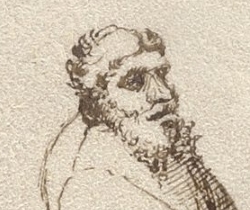
Resurgam HEMA
powered by TidyHQThe Master
The Master
The Master - Fiore Furlano de’i Liberi de Cividale d’Austria

(note: this is a condensed version of a larger article about the life of this Master. If you wish to learn more about Fiore, check our source here)
Fiore de'i Liberi was a knight and fencing master mainly active during the 14th century. Being born in the northern part of Italy, he traveled far and wide through Italic and Germanic lands to learn the art of combat - a thing he had taken to naturally from a young age. Throughout the introductions in his various manuscripts he expounds a bit on the details of his military career - it is through these introductions as well as some scant historical data from the Aquileian War of Succession that we are able to piece together his history.
- 1340's Born in Cividale del Friuli, Friuli
- 1381 - Trains his student Peter von Grünen for a duel, likely with Peter Kornwald.
- 3rd August 1383 - Fiore is given residence in the city of Udine.
- 30th September 1383 - The High Council of Udine tasks Fiore with the inspection and maintenance of the large crossbows and catapults the city used for its defenses.
- February 1384 - Udine asks Fiore to recruit a mercenary company to bolster their forces and bring them back to the city.
- May 23rd 1384 - Fiore is sworn in to keep the peace in one of Udine's districts.
- July 1384 - Udine is given a proclamation to cease hostilities or face severe repercussions. It seems probable given that Fiore is no longer mentioned in Udine's records that he moves on from the city at this point. The war is eventually settled in 1989 when a new Patriarch is named.
- 1395 - In Padua, Fiore trains Galeazzo Gonzaga of Mantua for a duel against the famous French knight Boucicaut (known also as Jean II le Maingre). The duel is ultimately ended by intervention before it gets too messy.
- 1399 - it is likely in this year Fiore trains two more individuals for duels - Giovannino da Baggio in Pavia and Azzone di Castelbarco.
- 1400's - Fiore begins work on his manuscript, "The Flower of Battle." Multiple copies are produced - the briefest of which is dated to 1409 and was said to have taken six months of effort. As it is likely two longer versions were produced before this one, It would seem that Fiore would have spent the majority of this decade writing.
- 1410 onward - Little is known for certain of Fiore's activity at this point. It's generally speculated that he died in the 1420's, possibly in France, though we have no concrete evidence.
In addition to these chronographical points, Fiore also tells us that he traveled Europe seeking the secrets of the arts that were known to few people - which he learned from various masters and their senior students. He gained notoriety among the nobility and was often asked to teach nobles, knights, and squires how to fight both in the barriers and in mortal combat. He also had to fight a total of five duels against "false" masters who were jealous of his skill and were incensed at his refusal to teach them.
Between traveling his world at great cost and personal expense, fighting for his life on the field of honor, training famous nobles and knights to fight in duels, and having direct military experience with aiding in the fortification of a city at war, Fiore has a long and proven track record of familiarity with combat. While it seems that he did not have as large an influence on the state of personal combat as others such as Johannes Liechtenauer or Filippo Dardi, his work remains an invaluable insight into the Art of Armed Combat in the Middle Ages.
